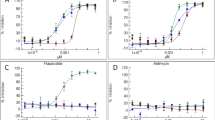Abstract
Accumulation of phenolic compounds (p-coumaric, caffeic, and ferulic acids and p-coumaric acid methyl ester) was followed in susceptible (Mustang) and tolerant (Flamingo) cucumber (Cucumis sativus) cultivars. The objective was to determine whether these compounds played a role in resistance against powdery mildew following a prophylactic treatment with Milsana (leaf extracts from the giant knot weed Reynoutria sachalinensis, polygonaceae). This treatment significantly reduced the incidence of powdery mildew in both cultivars. Phenolic compounds were extracted from leaves. In the hydrolyzed fraction containing phenolic aglycones, levels of p-coumaric, caffeic, and ferulic acids and of p-coumaric acid methyl ester increased in all treatments (with leaf extracts of R. Sachalinensis, powdery mildew, or both) except the control, one or two days after treatment. In the fraction containing free phenolics, from the tested compounds, only ferulic acid showed an increase in cv. Flamingo (tolerant), and was particularly evident following treatments. On the other hand, the amounts of hydroxycinnamic acids increased rapidly in the two cultivars following Milsana treatment, suggesting their role in disease reduction. All compounds showed antifungal activity when tetsed against common pathogens of cucumber (Botrytis cinerea, Pythium ultimum, and P. aphanidermatum), but in general methyl esters were more fungitoxic than their corresponding free acids. This study suggests that cucumber is able to release antifungal compounds that are instrumental in repressing powdery mildew infection. This response is seemingly independent from the level of genetic resistance associated with each cultivar.
Similar content being viewed by others
REFERENCES
Bandara, R. B. M., Hewage, C. M., Karunaratne, V., and Adikaram, N. K. B. 1988. Methyl ester of p-coumaric acid: Antifungal principle of the rhizome of Costus speciosus. Planta Med. 54:477–478.
Baranowski, J. D., and Nagel, C. W. 1982. Inhibition of Pseudomonas fluorescens by hydroxycinnamic acids and their alkyl esters. J. Food Sci. 47:1587–1589.
Baranowski, J. D., and Nagel, C. W. 1983. Properties of alkyl hydroxycinnamates and their effects on Pseudomonas fluorescens. Appl. Environ. Microbiol. 45:218–222.
Baranowski, J. D., and Nagel, C. W. 1984. Antimicrobial and antioxidant activities of alkyl hydroxycinnamates (alkacins) in model systems and food products. Can. Inst. Food Sci. Technol. J. 17:79–85.
Benner, J. P. 1993. Pesticidal compounds from higher plants. Pestic. Sci. 39:95–102.
Bennett, R. N., and Wallsgrove, R. M. 1994. Secondary metabolites in plant defense mechanisms. New Phytol. 127:617–633.
Borg-Olivier, O., and Monties, B. 1993. Lignin, suberin, phenolic acids and tyramine in the suberized, wound induced potato periderm. Phytochemistry 32:601–606.
ChÉrif, M., Asselin, A., and BÉlanger, R. R. 1994. Defense responses induced by soluble silicon in cucumber roots infected by Pythium spp. Phytopathology 84:236–242.
Daayf, F., Schmitt, A., and BÉlanger, R. R. 1995. The effects of plant extracts of Reynoutria sachalinensis on powdery mildew development and leaf physiology of long English cucumber. Plant Dis. 79:577–580.
Daayf, F., BÉlanger, R. R., and Schmitt, A. 1996. Alteration of cucumber leaf physiology by treatment with extracts of Reynoutria sachalinensis, pp. 245–251, in H. Lyr, P. E. Russel, H. D. Sisler (ed.). Modern Fungicides and Antifungal Compounds. Andover, UK.
Daayf, F., Bel-Rhlid, R., and BÉlanger, R. R. 1997a. p-Coumaric acid methyl ester, a phytoalexinlike compound from long English cucumber leaves. J. Chem. Ecol. 23:1517–1526.
Daayf, F., Schmitt, A., and BÉlanger, R. R. 1997b. Evidence of phytoalexins in cucumber leaves infected with powdery mildew following treatment with leaf extracts of Reynoutria sachalinensis. Plant Physiol. 113:719–727.
Dik, A. J., and VanDerStraayf. 1995. The effect of Milsana on cucumber powdery mildew under dutch conditions. Med. Fac. Landbouww. Rijksuniv. Gent. 59:1027–1039.
Geibel, M. 1995. Sensitivity of the fungus Cytospora persoonii to the flavonoids of Prunus cerasus. Phytochemistry 3:599–601.
Goodman, R. N., Kiraly, Z., and Wood, K. R. 1986. The Biochemistry and Physiology of Plant Disease. University of Missouri Press, Columbia, Missouri, 433 p.
Graham, T. L., Kim, J. E., and Graham, M. Y. 1990. Role of constitutive isoflavone conjugates in the accumulation of glyceollin in soybean infected with Phytophtora megasperma. Mol. Plant Microb. Interact. 3:157–166.
Grodzinska-Zachwieja, Z., Zhorniak-Nowosielska, I., Marciszewska, M., and Gatkiewicz, A. 1976. Antiviral activity of caffeic acid in in vitro studies. Acta Biol. Cracov. Ser. Bot. 19:29–33.
Hammerschmidt, R., and Kuc, J. 1982. Lignification as a mechanism for induced systemic resistance in cucumber. Physiol. Plant. Pathol. 20:61–71.
Hammerschmidt, R., Bonnen, A. M., Bergstrom, G. C., and Baker, K. K. 1985. Association of epidermal lignification with non-host resistance of cucurbits to fungi. Can. J. Bot. 63:2393–2398.
Higgins, V. J., Hollands, J., and Bates, D. K. 1995. Phytoalexins in forage legumes: Studies on detoxification by pathogens and the role of glycosidic prescursors in roots, pp. 391–403, in M. Daniel and R. P. Purkayastha (eds.). Handbook of Phytoalexin Metabolism and Action. Marcel Dekker, New York.
Macko, V., Staples, R. C., Renwick, J. A. A., and Pirone, J. 1972. Germination self-inhibitors of rust uredospores. Physiol. Plant. Pathol. 2:347–350.
Ndubizu, T. O. C. 1976. Relations of phenolic inhibitors to resistance of immature apple fruits to rot. J. Hortic. Sci. 51:311–316.
Siegrist, J., Jeblick, W., and Kraus, H. 1994. Defense responses in infected and elicited cucumber (Cucumis sativus L.) hypocotyl segments exhibiting acquired resistance. Plant Physiol. 105:1365–1374.
Stahmann, M. A., and Demorest, D. M. 1973. Changes in enzymes of host and pathogen with special reference to perioxidase interaction, pp. 405–422, in R. J. W. Byrde and C. V. Cutting (eds.). Fungal Pathogenicity and the Plant's Response. Academic Press, London.
Stein, B. D., Klomparens, K. L., and Hammerschmidt, R. 1993. Histochemistry and ultrastructure of the induced resistance response of cucumber plants to Colletotrichum lagenarium. J. Phytopathol. 137:177–188.
Author information
Authors and Affiliations
Rights and permissions
About this article
Cite this article
Daayf, F., Ongena, M., Boulanger, R. et al. Induction of Phenolic Compounds in Two Cultivars of Cucumber by Treatment of Healthy and Powdery Mildew-infected Plants with Extracts of Reynoutria sachalinensis. J Chem Ecol 26, 1579–1593 (2000). https://doi.org/10.1023/A:1005578510954
Issue Date:
DOI: https://doi.org/10.1023/A:1005578510954




